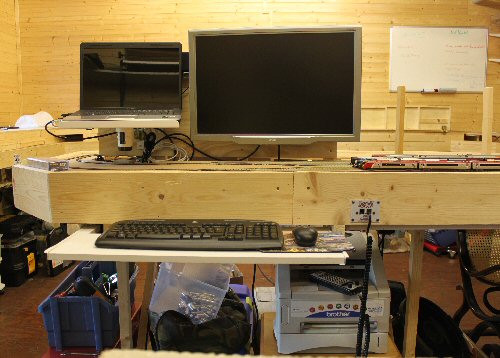Computer control isn't for everyone; equally for others it is a very important part of their model railway. This section describes how the "Traincontroller" software has been used to control the South Downs Railway.
Why did I want computer based control? Two reasons, I suppose. Firstly, I don't find driving model trains particularly inspiring. If I can press a button and have a train go from A to B, I'm happy. Secondly, the railway is too large for one person to control anything like all the activity that should be going on at any one time. Using a computerised control approach, the computer can drive some "background" traffic and can run trains to and from stations. A human operator still has work to do - for example splitting up goods trains, changing the loco on passenger trains at terminus stations and the like. The computer program allows a "tempo" of train operations to be maintained alongside the human involvement.
Computer control isn't a "take it or leave it" concept: there are lots of ways it can be used. They can be more intrusive or less intrusive way according to your wishes.
My railway is controlled from a PC located by the fiddle yard. I have a laptop plus a large monitor; this kit used to be expensive, but is far less so today. For those who want a less intrusive approach, it's entirely possible to use a sub £200 laptop with free software: so cost need not be a prohibitive barrier.

This is the home of the South Downs Railway - a fictitious, modern image (ish) railway set in southern England modelled in N gauge. The layout is 15 x 10 feet (5x3m). It is Digitrax DCC controlled, and automatically controlled using a PC running "Traincontroller" software.
The layout has been "on the way" for over 10 years, and we do make progress, slowly. All of the track has been laid, and most of the train operations have been tested. The "main" track loop is a "folded dog bone" arrangement around 3 and a half sides of a rectangle. Clanfield station is complete, and scenic. Petersfield station is in the "scenic development" phase. The oil terminal has been ballasted. Portsmouth station has its track laid covering three distinct areas - the passenger side, the container terminal and the GWR preservation area with an engine shed and turntable.
We've completed the work to develop the electronics needed to control the railway. there are a number of CML Electronics modules involved: DAC20 point control, SIGM20 signal control, MSC8 scenery decoders and a TXC1 turntable controller. The railway is Digitrax controlled, with some of their products too.
Rolling stock is entirely shop-bought, with DCC decoders fitted. We've adopted Dapol magnetic couplings: some of our stock pre-dates NEM pockets so this requires effort. They work well, and we have added the magnets to operate them in terminus tracks where trains will separate.
Main line train operations are fully computer controlled. The "Traincontroller" software moves the trains from one place to another, making sure that there are no collisions. It is possible to manually drive a train, obeying the signals on the way, but the points are controlled automatically on the main line. In the terminus stations (Clanfield, Portsmouth and the Eastleigh oil depot) there are opportunities for manually driven train movements - repositioning a locomotive to the other end of the oil train so it is ready to go for example. The operators have pushbutton panels to control points in the terminus areas, and there is interlocking with Traincontroller so that a manually driven train doesn't upset an automatic train operation.
It's great to see it in operation: there can be 5 or 6 trains in various stages of moving around the railway at the same time. They all wait for each other with no conflicts. Two or three people could operate most of the railway now - one dispatching one the computer, and the others manually preparing trains at the stations.
